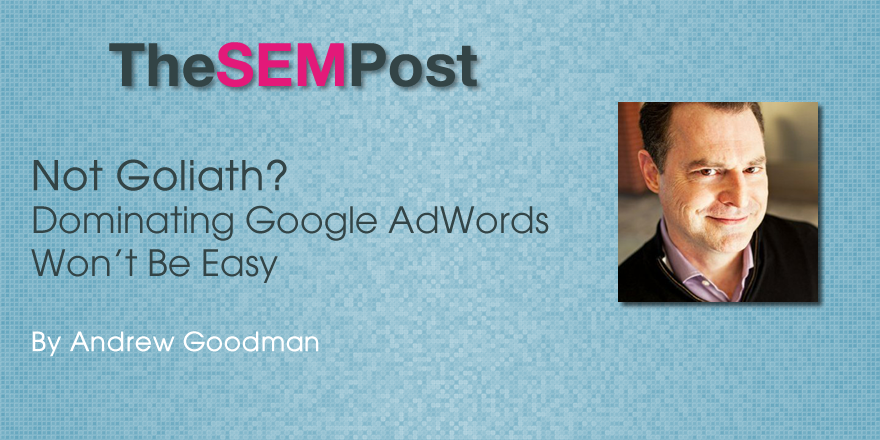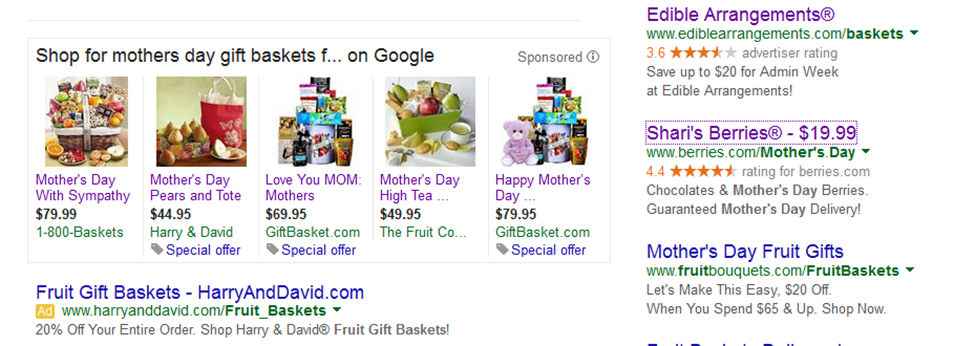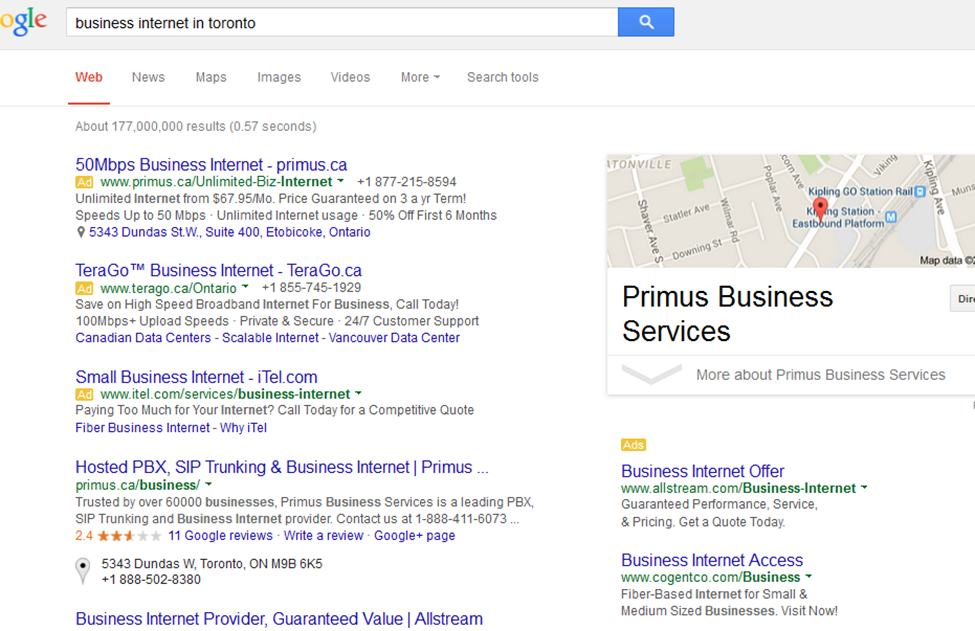 With all the talk of bootstrapped startups, advantages of “nimble players,” and Davids taking down Goliaths, you might be excused for exhibiting an excess of optimism as you enter the PPC fray, even if you’ve heard scary stories about rising click prices.
With all the talk of bootstrapped startups, advantages of “nimble players,” and Davids taking down Goliaths, you might be excused for exhibiting an excess of optimism as you enter the PPC fray, even if you’ve heard scary stories about rising click prices.
I’m a big proponent of the personality, ingenuity, speed, and agility you find in the small business community. At our agency, we count as our greatest successes clients that started out small, and ended up surprisingly big. But those “now relatively big” players, of course, don’t prove that small is beautiful – they wanted to get bigger so they could avoid being squashed! The small spirit is still there, but in “newly big” players, the painful disadvantages of days gone by have given way to greater efficiencies, higher consumer trust levels, and the discovery of possibly inadvertent yet advantageous little Easter Eggs Google provides to help big brands. It’s almost proof that bigger is better.
Today’s next wave of small and hopeful companies don’t have these advantages yet. They just need to grow. And arguably, that isn’t going to happen unless they have a clear sense of the obstacles – and opportunities – that await if they can “mimic” Goliath; not by copying or acting like a wannabe, but understanding some of the “big company perks” that Google has built into AdWords. [Yes, some of these principles apply to Bing as well; in terms of PPC auction features and formats, Bing is admittedly a follower of Google, though.]
While you can’t always quite put your finger on why or how, it’s become clear that Google likes recognizable brands. It’s actually not that hard to prove nowadays. If you’ve got any good intelligence on what Googlers on the sales and business development side do, you know they target large companies and certain sexy sectors for a steady schmooze. All those seminar rooms and floors of space at dozens of Google offices around the world have to be there for some reason – it isn’t all engineering.
The format of the ad auction, and the tacit principles of providing a level playing field, won’t allow Google to blatantly discriminate on the basis of company size or coolness. But by building the platform in a certain way – probably, intentionally – they’ve put powerful tools in the hands of businesses with greater resources and larger audiences. Here is a short list of some obvious – and not-so-obvious – ways that the AdWords auction and feature set may provide a bigger boost to large businesses than many realize, despite it being technically a platform open to anyone:
OBVIOUS:
- Multiple types of ad extensions including SiteLinks, review, callouts, seller ratings, and more.
- Consumer retail categories increasingly dominated by feed-based Product Listing Ads;
- Little-understood feature sets, approval processes, and beta products that ideally require access to senior-level account reps.
NOT SO OBVIOUS?
- Google has stated at different times that additional takes on historical keyword and ad CTR may be factored into the Quality Score algorithm. This often includes measures associated with the Display URL. Large companies are trusted and get clicked. True brands also have loyalty and even “brand love” going for them, which could translate into positive numbers when it comes to other metrics attempting to measure user satisfaction.
- Tinfoil hat version of the above takes it a step farther. Google *could* be tinkering with the algorithm to greenlight certain types and sizes of companies in ways far more sophisticated than we might realize. However, if they are doing that, it’s apparent it doesn’t always work. It’s also apparent that many larger companies do not appreciate said largesse, as it’s apparent from C-level exec comments and some large company spend levels that many companies do not value their relationship with Google.
- Gaining API access and creating custom bid management and reporting tools isn’t the province of most small companies. To their credit, Google makes the platform itself powerful, and they’ve made possible something called AdWords Scripts, which many advertisers are using to build powerful custom automation methods.
- Data, data, data. The largest businesses have the ability to calibrate their bidding and prioritization schemes very accurately to take advantage of the exact value of a customer across large product lines and situations. Smaller businesses make a lower profit and stumble down a lot of blind alleys, but of course this is something of a Darwinian experience. You won’t have much to say about it if you die out, but if you get to the stage where you’ve amassed significant learnings, and you’re still going, you’re that one step closer to being the Goliath you once feared.
- Shelf space dominance. Conglomerates are so cagily diversified nowadays, they can show you what looks like competition between a cute and scrappy upstart, and the old established player, when in the end all the profit flows back to the same shareholders. See screen shot below. Is Shari’s Berries really the little upstart it appears to be, or is it owned by an $860 million retail conglomerate?
- Audience assets can be leveraged with remarketing. The largest companies have made past investments, often have large content assets, etc., that lead to repeated large-scale direct website visits. These pre-existing audiences can be leveraged as cost-effective remarketing audiences.
- I pay scant attention to these matters myself, but you may discover when setting up a new AdWords account that you can either sign up for the type of account that allows access to all features, or one that keeps you blissfully unaware of many of the key AdWords control mechanisms. There’s also something called AdWords Express. I tend to believe that being a successful business owner, and “training wheels,” are fundamentally incompatible. Ease of use is a good thing – within reason. AdWords isn’t for dabblers.
So how do you take down Goliath?
I’ve already tried to illustrate that it might be harder than it looks, but depending on your perspective, it might turn out to be more doable than I’m making it sound.
Here are just a handful of reasons you can win, despite being smaller:
- The usual clichés about large business complacency may apply. Some large companies sit back, ignoring “needy” or “performance-based” channels like PPC – or for that matter, SEO, or optimizing for local results. In this screen shot, for example, you can see Canada’s larger telcos like Bell and Rogers (both advertising, in this case well below the fold) hanging back, bidding down, rocking weak Quality Scores, ignoring ad extensions… for whatever reason, making upstarts like Primus and Terago look like the deep-pocketed ones? The reasoning seems to be: we’re big fish, so we have other channels. The Google pond is an afterthought.
- Although large businesses may do better on things like seller ratings extensions, almost any business can thoroughly work on their SiteLinks extensions and callout extensions. You might consider the review extension as a great example of a small feature that would be unavailable (chicken-eggishly) to the smallest upstarts, but become a game-changing advantage for those businesses that have begun to get media recognition. Joining the ranks of the Goliaths can come sooner than you think.
- The Quality Score algorithm isn’t particularly evil, just slightly so. Reported Quality Scores don’t provide tight, actionable feedback, to be sure. But if you think obsessively about the user intent in your ad group structures, use of match types, ad copy, and information scent from landing page and beyond, Quality Score benefits do follow. Typically, you see gradual improvements in your account and may enjoy that feeling of seeing more “surprising” or “undeserved” Quality Scores of 8 or 9, where at one time you were struggling as an unproven upstart with what you felt were a lot of “undeserved” Quality Scores of 3, 4, or 5.
- Small can be beautiful, if it leads to you going into a quiet room and really thinking with empathy about the kinds of ads, landing pages, and unique products that will delight your target customer. Slow down, and please someone with your offering… not everyone. When you do that and do it consistently, the growth takes care of itself.
- You might not be able to remarket to your own audience, but with the increasing array of behavioral display ad options out there, you could experiment with audiences that mimic those of your large competitors. If the big guys aren’t bidding on high-intent behavioral ad inventory, why don’t you? Moreover, your own direct remarketing efforts are a great way to start closing those early sales in a cost-effective manner. Small can be beautiful.
*Note on research: Despite employing the catchprase “taking down Goliath,” I haven’t yet read Kevin Ryan’s book of the same name. I have read the Gladwell book.
Andrew Goodman
Latest posts by Andrew Goodman (see all)
- PPC Audits: A Guide to Playing Fair - July 22, 2015
- What Do These Google AdWords Features Really Do? - May 26, 2015
- Not Goliath? Dominating AdWords Won’t Be Easy - April 29, 2015
- Unleash Your Quality Score Beast Mode (Bing Ads Edition) - March 3, 2015
- Google, Partners, and Loyalty (Or: Thanks for the Espresso Machine, But…) - February 3, 2015


[…] Not Goliath? Dominating AdWords Won’t Be Easy, The SEM Post […]